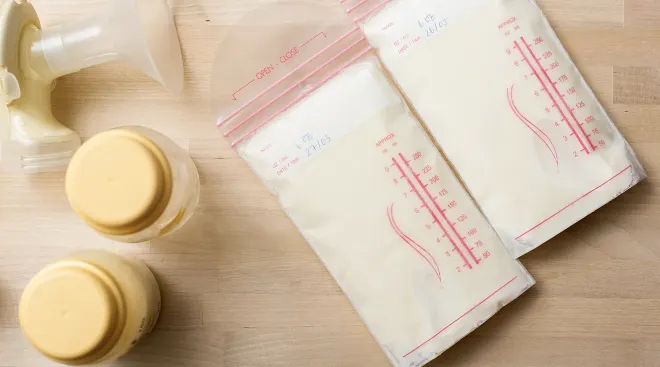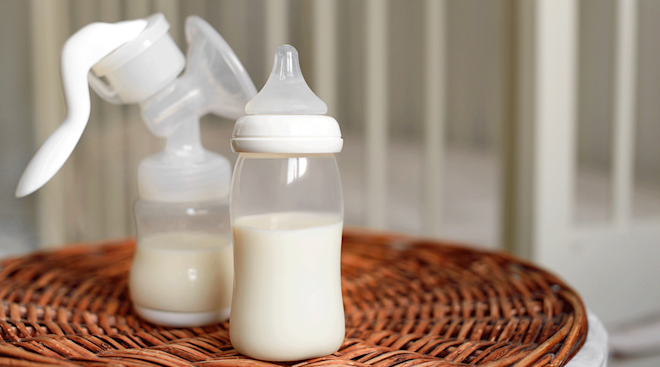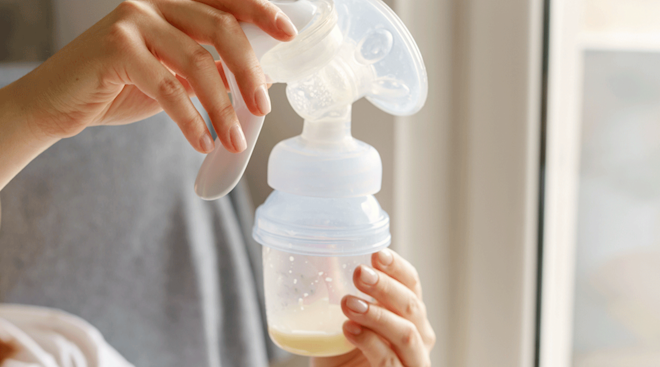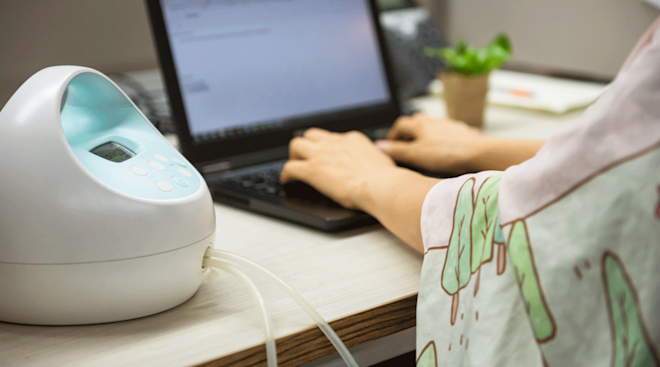How to Relieve a Clogged Milk Duct
Nursing is one of the most natural interactions a mother can have with her newborn, but the experience is different for every woman, and it’s not always perfect. One day the milk flow is effortless, then suddenly there’s barely a trickle and your chest feels like it’s on fire. It’s enough to sour anyone’s motivation to breastfeed. But don’t give up just yet—you may simply be suffering from a clogged milk duct.
Below, we tackle all your top questions about blocked milk ducts. What does a clogged duct look like? What causes blocked milk ducts, is it safe to continue nursing if you think you have one, and how can you find relief? Whether you’re experiencing clogged milk duct symptoms or simply brushing up on what you might expect when breastfeeding, keep reading for the complete lowdown on blocked milk ducts.
So what would prompt a blocked milk duct to develop? “A clogged milk duct is when the milk is backed up inside it,” which can make pumping and nursing excruciatingly painful, says Leigh Anne O’Connor, IBCLC, a certified lactation consultant in New York. If the blocked milk duct isn’t resolved quickly, it can lead to bigger issues, such as inflammation—a condition known as mastitis—and an all-out milk stoppage, which in turn can lead to infection.
It’s not always easy to know what causes a clogged milk duct, but there are plenty of possible culprits, including:
• Residual breast milk. Most of the time, what causes a clogged milk duct is not removing all the breast milk in a timely manner. As a result, the milk backs up and creates a blockage.
• Breast pressure. Wearing a tight bra, tight clothing or other restrictive gear (you know, that hefty baby bag you’ve been lugging around across your chest) can lead to a clogged milk duct. So can lying on your breasts while sleeping or even exercising.
• Weak pump. Similar to a poor latch, a bad pump could lead to a drainage issue.
• Bad latch. When baby isn’t latching on to you properly, they can’t fully drink all the milk you’re making. A backup of milk eventually occurs and leads to a plugged milk duct.
• Stress. Just as the rest of your body won’t run as smoothly because of too much stress, the same goes for your breasts. Stress can slow down the production of the hormone oxytocin, which helps your breast release the breast milk. So take it easy. Sleep when baby sleeps, and ask others for help with chores. Let your body do its thing.
Whether you’re in the early stages of breastfeeding or have been at it for a while, a blocked milk duct can strike when milk isn’t being fully drained from your breasts. So what are some of the telltale clogged milk duct symptoms?
“Mothers may first notice an area of the breast that feels firm, bumpy, or even with a rope-like texture,” says Becky Kramer, RN, IBCLC, a nurse and lactation consultant at Gundersen Health System in La Crosse, Wisconsin.
As any new mom will tell you, a clogged milk duct can feel as if some vicious creature has set up residence in your breast. Besides causing pain and suffering for the mom, it can make babies cry. “When nursing the baby on that [affected] side, my daughter would get frustrated and impatient,” says Sarah B., who describes the clogged duct she experienced as “a hard ball that hurt to touch.” “It ached and felt bruised,” she says. That’s not uncommon—nor are they the only clogged milk duct symptoms. You might also feel:
- sore, tender breasts
- the formation of a small lump or lumps
- swelling and redness
- areas of the breast that are warm to the touch
Clogged milk duct vs. mastitis
If you let your clogged milk duct go untreated, it can turn into mastitis very quickly—sometimes within a matter of hours. Mastitis can also occur if bacteria enters the milk duct through a crack in the nipple due to poor latching or pumping, which can lead to an infection.
So how can you tell the difference between a blocked duct and mastitis? Generally, blocked milk duct symptoms are localized to the area around the lump, which is usually red. You may not feel any pain, but if you do, it will be centered around the lump.
With mastitis, your whole breast will likely feel tender and sore and may even burn. You might have one or multiple lumps, and they will feel warm or hot to the touch. Many mothers also experience flu-like symptoms, such as fatigue, chills and fever. Don’t underestimate the severity of mastitis. If you think you may be suffering from mastitis, contact your doctor right away.
While you don’t necessarily need to consult a healthcare provider if you have symptoms of a clogged milk duct, O’Connor does recommend checking in with your family doctor if you have symptoms of mastitis, since the infection may need to be treated with an antibiotic.
If you think you may have a clogged duct, you can resolve the plugged milk duct at home. Your first instinct may be to stop nursing. That’s what you do when something is hurting you, right? Unfortunately, no—not when it comes to a clogged milk duct. Continuing to nurse is really the best path toward relief.
“Feed baby often, or for moms who are pump-dependent, pump at regular intervals,” Kramer says. “Be in tune to your body. If you start to notice an area of the breast that feels full or uncomfortable, add in some massage while feeding or pumping right away.”
“I encourage moms to rest, keep the milk flowing, rest, stay hydrated, rest, fix the latch, go braless and did I mention rest?” O’Connor adds. “Rest is so important in these cases.”
Here are some other plugged duct treatment options that have worked for moms:
• Hot compresses. “I had to be vigilant about applying hot compresses and pumping or nursing on schedule,” says Meagan E., who noticed that she’d get a clogged milk duct every time her nursing schedule changed. It was as if her body was trying to adjust, she says.
• Nursing support. “I tried hot compresses, pumping between nursing sections and lanolin,” Kim M. says. “Eventually, I reached out to La Leche League, a nonprofit group that supports breastfeeding moms. They sent a breastfeeding coach—another breastfeeding mom—to help me, for free. She showed me that my baby wasn’t latching on correctly, and that the baby had to be taught how to breastfeed properly. It was as simple as that. So don’t be afraid to ask for help. Just because you’ve had a baby, it doesn’t mean you magically know how to do everything right away. I could have saved myself weeks of grief if I had asked someone earlier.”
• Hot showers. “I directed the spray onto the affected nipple area—which was incredibly painful—and slowly expressed with my hand to try to loosen the milk from the duct,” says Lauren S., who found that hot showers along with nursing got the milk moving and took care of her blocked milk duct.
• Massage. The movement helps loosen the clog. “As soon as it would pass, everything went back to normal,” says Sarah B., who also treated her blocked milk duct using heating pads and hot showers in addition to “pumping and nursing around the clock.”
• Cold compresses. “Cold compresses may be more comforting for some mothers if heat is not giving them relief,” Kramer says.
When it comes to alleviating your symptoms, it may be a matter of trial and error. Try out each of these tricks and see what works best for you. It may even require a combination of them, such as massage and hot showers or nursing support and cold compresses. Above all, remember to keep breastfeeding and get as much rest as possible.
If you’re proactive in your clogged milk duct treatment (and pain is always a great motivator), symptoms can clear up quickly, with many moms saying they found relief in one to two days. The goal is to find a remedy that is right for you. Hot compresses and massage may work for one mom, while making sure baby is latching on properly could be the solution for another.
“If a plugged milk duct persists [for longer than two days] and there’s no relief, there’s a chance it can develop into mastitis,” Kramer says. “With mastitis a mother develops a fever (100.4 degrees Fahrenheit), begins to feel fatigued and achy and should seek medical attention immediately.”
As the saying goes, an ounce of prevention is worth a pound of cure. Many preventive strategies are the same as the plugged duct treatments. Work them into your routine, and chances are you’ll keep your breasts—and baby—happy and healthy.
• Nurse. Keep milk flowing so nothing gets left behind. Hand-express or pump when nursing isn’t possible or if baby isn’t creating enough drainage.
• Bring in a pro. Breastfeeding experts can help you make sure baby is latching on properly. “I had so many issues in the beginning that a lactation consultant came to our house to help,” Sarah B. says. “I also went to lots of drop-in lactation classes, which were extremely helpful.”
• Get stress off your chest. Skip the bra when you can to let the girls be free of restriction. Also, avoid sleeping on your stomach or doing exercises that put undue stress on your breasts. “I also recommend staying away from underwire bras in the first couple of weeks when the breasts are most sensitive,” Kramer says.
• Sleep. We know. It’s nearly impossible when you have a tiny, needy human to raise. But don’t be shy about asking family members and friends for help so you can carve out a little R&R for yourself.
• Chill out. De-stress by exercising, meditating or doing whatever else you enjoy. Don’t be so hard on yourself. You’re an awesome mom—even if you don’t believe it most days. Taking time for yourself will help you better care for baby in the long run.
• Hydrate. Drink plenty of water to help keep milk flowing more freely and avoid a blocked milk duct. While non-nursing women should drink about nine cups of water each day, breastfeeding moms should up those fluids to about 13 cups.
As natural as breastfeeding may be, that doesn’t mean it doesn’t come with its fair share of ups and downs. Some new mothers find it easy to breastfeed right off the bat, only to run into clogged milk ducts or other issues down the road.
Be patient, and try not to compare yourself to other mothers. You and baby’s journey is unique. When in doubt, speak with your doctor or contact a lactation consultant if you are experiencing pain or other unpleasant symptoms when nursing.
About the experts:
Leigh Anne O’Connor, IBCLC, is a certified lactation consultant in New York with more than 20 years of experience working with breastfeeding families. She is a past president of the New York Lactation Consultant Association.
Becky Kramer, RN, IBCLC, is a nurse and lactation consultant at Gundersen Health System in La Crosse, Wisconsin.
Please note: The Bump and the materials and information it contains are not intended to, and do not constitute, medical or other health advice or diagnosis and should not be used as such. You should always consult with a qualified physician or health professional about your specific circumstances.
Plus, more from The Bump:
Navigate forward to interact with the calendar and select a date. Press the question mark key to get the keyboard shortcuts for changing dates.





















































